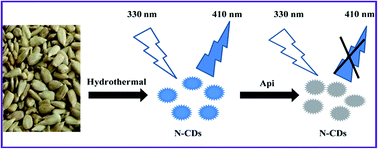A highly selective and sensitive fluorescence sensor for the detection of apigenin based on nitrogen doped carbon dots and its application in cell imaging†
Abstract
A highly selective and sensitive fluorescence detection platform based on nitrogen doped carbon dots (N-CDs) is developed for the first time for the determination of apigenin (Api) in celery. N-CDs were obtained by one-step hydrothermal treatment of sunflower seeds. High-resolution transmission electron microscopy, X-ray photoelectron spectroscopy, UV-vis absorption and fluorescence spectroscopy were used to characterize the resultant N-CDs. The presence of Api could lead to the obvious fluorescence quenching. The possible fluorescence quenching mechanism was verified to be a dynamic quenching mechanism. The proposed sensing platform was successfully used to detect Api and exhibited high sensitivity and selectivity. The linearity ranged from 0.1 to 60 μmol L−1 with a detection limit (3σ) of 80 nM. The recovery of this assay was in the range of 90.67–109.02%. Moreover, possessing fascinating luminescence properties, low toxicity and good biocompatibility, the resultant N-CDs have displayed potential applications in cell imaging.



 Please wait while we load your content...
Please wait while we load your content...